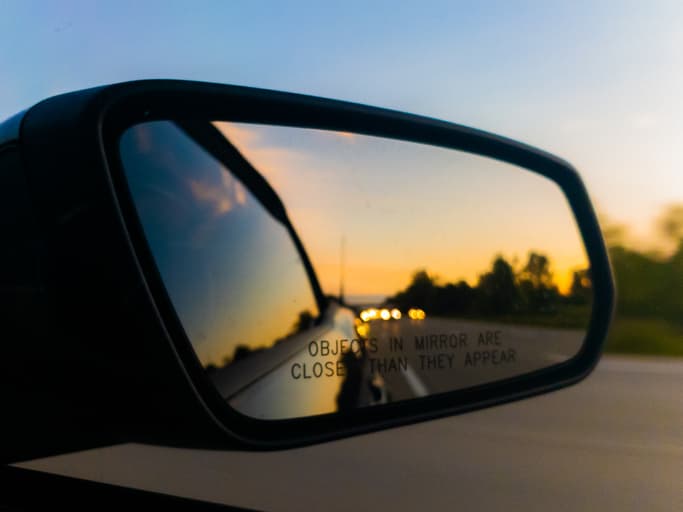Using And Adjusting Your Wing Mirrors
Stay In The Know

As a driver, making sure that your wing mirrors are adjusted correctly, and that you’re using them properly, is paramount. Understanding the importance of these mirrors will not only keep you safe while you’re behind the wheel, but it can ensure the safety of other motorists, cyclists and pedestrians too.
The truth is, failing to make sure your mirrors are adjusted properly and checking them while driving is one of the most common bad driving habits for motorists - despite the fact that it is an integral part of getting ready to pass your driving test.
In this article, you’ll learn how you can make sure your mirrors are positioned correctly, and how you should be using them.
How To Use Your Wing Mirrors
According to the Rules of the Road document published by the Road Safety Authority (RSA), a vehicle must be fitted with a rear view mirror so that you can see what is approaching from behind, as well as mirrors on each side. These are more commonly known as wing mirrors, and they allow you to see behind and to the sides of the vehicle while you’re driving.
The RSA states that you should check these mirrors regularly while you’re driving so you can see what is going on to the rear and both sides of the vehicle. It also states that you should check these mirrors before moving off from a stationary position, signalling, changing lanes and overtaking road users, such as other vehicles or cyclists. You should also check these mirrors if you are slowing down, stopping, turning a corner and even when you’re opening the door to exit your vehicle.
Checking your wing mirrors frequently, as well as your rear view mirror, is extremely important as it can significantly reduce the chances of you becoming involved in an accident, keeping you, your passengers and other road users safe.
How To Adjust Mirrors
So that you’re able to use your wing mirrors correctly while you’re out and about on the roads, it’s vital that they are both set in the optimum position - but how do you do this exactly?
To get the position of your wing mirrors just right, you should start by getting into the driver’s side of the vehicle. Make sure your seat is adjusted so that you feel comfortable, ensuring that you have plenty of legroom and you’re sitting close enough to the steering wheel. You might want to adjust the seat higher or lower to get this position just right. You should be able to reach all the car’s main controls, including the handbrake, gear stick, steering wheel, brake and accelerator, without stretching or straining yourself.
Using your car’s wing mirror adjustment controls, which are usually located on the arm panel of the driver’s inside door or on the steering wheel, press the buttons until the side of the vehicle is just about visible. Aside from the left and right buttons, you might find that you also have to use the up and down options to get this spot on. If your vehicle does not have electric wing mirror adjustment controls, you should be able to simply adjust both mirrors by gently using your hand to adjust them into the correct position.
What Should I See In My Side Mirrors?
You should be able to see just a small sliver of the side of your vehicle in both of your wing mirrors while you’re driving. This will give you a wide view of the areas to the side and behind the car, which in turn can reduce blind spots.
Where Are The Blind Spots On A Car?
A blind spot is any area of road that you cannot see when you look through the windscreen or when you use your rear view or wing mirrors. Sometimes, a blind spot can mean that you’re unable to see another vehicle, cyclist or even a pedestrian.
A typical car often has two main blind spots. These are to the rear left and the rear right of the vehicle. The design of some vehicles can also create A-pillar blind spots. This is when the A-pillars - the material either side of the windscreen that arch up to the roof of the car - block your view and therefore creates a blind spot.
It’s important that you’re aware of the blind spots of your car, and you should always check them when you’re moving left or right, such as when you’re changing lanes on a motorway. You should also take extra care checking your blind spots when you’re travelling along busier roads as there is more chance of another car, cyclist or pedestrian slipping into these blind spots. To ensure you’re covered in the event of a collision caused by failing to see something in your blind spot, it’s important that you have a car insurance policy in place.
How Do Blind Spot Mirrors Work?
In Ireland, it’s advised that all Heavy Good Vehicles (HGVs) must have front-fitting, wide-angled ‘Cyclops’ mirrors which have been designed to eliminate blind spots - and the good news is, you can purchase similar blind spot mirrors for your car too.
Blind spot mirrors usually have a curved design, and when attached to the wing mirror, they offer a wider field of vision while you’re driving. The angle provided by the blind spot mirror allows you to see what your wing mirror would miss, even if it is positioned correctly.
